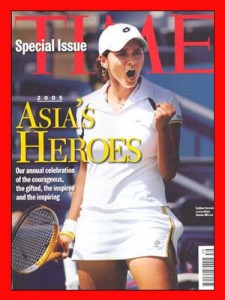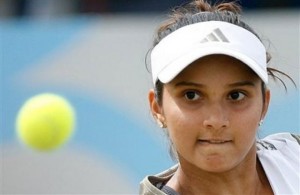Sania Mirza is a source of pride in India. She is the first Indian woman to:
- Win a WTA (Women’s Tennis Association) tour title of any kind
- Win a Grandslam Title
- Surpass US $1m in career earnings
She has also won the Arjuna Award, which is the highest sports honour in India, and the Padma Shri, which is the fourth highest civilian award in India; she was named one of the “50 heroes of Asia” by Time Magazine, and named by The Economic Times in the list of “33 women who made India proud“.
However, to many Indian Muslims, she is a media personality, who doesn’t wear the “proper” attire that a Muslim woman is supposed to be seen in. She dresses like any other tennis sports star, and is popular for her style statements as for her skill with the racket. This resulted in a Maulvi in Midnapore (West Bengal, India) issuing a fatwa on her dress code stating “The dress she wears on the tennis courts…leaves nothing to the imagination.” He also said she should follow the example of Iranian women who wore head scarves and long tunics when they played in badminton tournaments. Islamist groups such as Jamiat-ulema-e-Hind allegedly threatened to disrupt her tennis matches.
Recently another fatwa was also issued against her, for living together with her current husband, before their marriage; the fatwa stated that ”It’s un-Islamic for a man and woman to see each other during the ceremonies before the ‘nikah.’” (Mirza’s husband stayed in her parental home for few weeks prior to their wedding. )
Mirza was also heavily criticized for hugging non-Mahram men after a match, and for wearing t-shirts with bold statements on them. She also spoke in a conference about safe sex, which was understood as implying that she supported premarital sex, following which her effigy was burnt.
Fatwas have caught the fancy of the people worldwide, and is popularly used by media, to project Islam as a misogynist religion with impractical restrictions. Zakir Naik, in his speech on the subject, explains why Muslims or Ulemas should not be giving so much importance to Sania Mirza’s dress code. Naik speaks about the importance of “diluting” the global effect of labeling Sania Mirza’s dress code as Haraam, for the sake of a positive representation of Islam in the media. He further says that she is a “lesser sinner” than Muslim male cricketers who do not offer Salah at all. However, he also mentions her world ranking is “only” 34, and doesn’t deserve all the attention it is garnering.
In another related article, Dr Mookhi Amir Ali, while stating that he has better work to do than follow Sania Mirza’s career, goes onto say that she should have used her stature, as a successful Muslim woman, to question the short skirts and bring modesty into the game. She also should have worn a wrap right after the game was over, or chose not to wear the tennis dress, in all the advertisements she was featured in – the very advertisements which chose to feature her BECAUSE she was a tennis star. The only attribute which will make her a good Muslim, according to him, is if she brought about any changes in the accepted “dress codes” for women in professional tennis.

Mirza’s interviews were she states that she derives her mental strength from her regular prayers, aren’t mentioned. Her father’s statement of her religiously observing her Ramadan fasts are forgotten. What is camouflaged all along, in her spunky attire, and her sportswear, is that she is an extremely successful sports woman, who publicly attributes it to her religion. The glory she brings to Islam, with or without her tennis skirts, is forgotten by all, including the factual Naik. Being an international sports star, and the first Indian woman to achieve everything she has achieved, should, in effect, be the reason people should be more attracted to Islam.
India is a country where Muslims are the minority, the literacy rates of Muslim women are much lower than for women of other religions, and Muslims in general are largely discriminated against. So instead of being a “lesser sinner,” or an “OK” Muslim, Sania Mirza deserves recognition for bringing positive attention to Islam. For being the first Indian woman to achieve so many laurels that no one of any faith was able to do before her.












